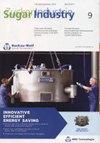Blackstrap molasses as a source of bioactive compounds for the green synthesis of nanoparticles
IF 0.2
4区 农林科学
Q4 FOOD SCIENCE & TECHNOLOGY
引用次数: 0
Abstract
By-products from the sugar industry (e.g., blackstrap molasses) can be a source of bioactive compounds (e.g., phenolics) known to have antimicrobial, antioxidant, anticancer, and anti-inflammatory properties. These bioactive molecules can be used in the green synthesis of metal nanoparticles. Metal nanoparticles have gathered attention because of their novel physico-chemical properties and potential biological applications (e.g., biocides, fungicides, pesticides, targeted drug and gene delivery, biosensing, medical implants, and plant biostimulants). Gold, silver, iron, and copper nanoparticles are of particular interest as they can be easy to operate and are cost effective, and biocompatible, and their biological activities can be enhanced by surface modifications. In this study, the reducing potential of the phenolic compounds in molasses was investigated for the synthesis of silver nanoparticles without the external addition of reducing agents. The reddish color formation and peak appearance at 420 nm were indications of the successful synthesis of the silver nanoparticles. The synthesized nanoparticles and reducing biomolecules were further characterized by microscopy (SEM, TEM, EDS) and spectroscopy (FTIR) techniques indicating nanoparticles of spherical shape and with particle sizes ranging from 15 nm–45 nm. Their antimicrobial activity was evaluated against several Gram-positive and Gram-negative bacteria. The synthesized nanoparticles showed a biocidal effect, further confirmed by microscopy techniques. It appears that the nanoparticles are interacting with the cell surface of bacteria, penetrating the cell and also causing the disruption of intracellular organelles.黑带糖蜜作为绿色合成纳米粒子的生物活性化合物的来源
制糖业的副产品(如黑糖糖蜜)可能是已知具有抗菌、抗氧化、抗癌和抗炎特性的生物活性化合物(如酚类物质)的来源。这些生物活性分子可用于金属纳米颗粒的绿色合成。金属纳米颗粒因其新颖的物理化学特性和潜在的生物应用(如杀菌剂、杀菌剂、杀虫剂、靶向药物和基因传递、生物传感、医疗植入物和植物生物刺激素)而受到关注。金、银、铁和铜纳米粒子特别令人感兴趣,因为它们易于操作,成本效益高,具有生物相容性,并且它们的生物活性可以通过表面修饰来增强。在本研究中,研究了糖蜜中酚类化合物在不添加还原剂的情况下合成纳米银的还原电位。在420 nm处形成的红色和峰的出现表明银纳米颗粒的成功合成。通过显微镜(SEM, TEM, EDS)和光谱(FTIR)技术对合成的纳米颗粒和还原性生物分子进行了进一步的表征,表明纳米颗粒为球形,粒径在15 nm - 45 nm之间。对几种革兰氏阳性和革兰氏阴性细菌进行了抑菌活性评价。合成的纳米颗粒显示出杀灭生物的效果,通过显微镜技术进一步证实。纳米颗粒似乎与细菌的细胞表面相互作用,穿透细胞,也导致细胞内细胞器的破坏。
本文章由计算机程序翻译,如有差异,请以英文原文为准。
求助全文
约1分钟内获得全文
求助全文
来源期刊

Sugar Industry-Zuckerindustrie
工程技术-食品科技
CiteScore
0.50
自引率
50.00%
发文量
22
审稿时长
18-36 weeks
期刊介绍:
Sugar Industry / Zuckerindustrie accepts original papers (research reports), review articles, and short communications on all the aspects implied by the journals title and subtitle.
 求助内容:
求助内容: 应助结果提醒方式:
应助结果提醒方式:


